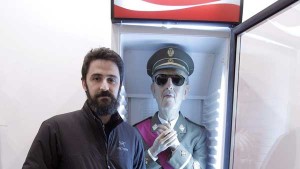
More than 36 years after heading for the great military dictatorship in the sky, General Francisco Franco proved his enduring pulling power by stealing the show at last week’s annual ARCO contemporary art fair, appearing in a fridge and as a fast-spinning bust; even his eyebrows were a big draw.
Siempre Franco (Forever Franco) was the star attraction at the five-day artfest, a life-size hyperrealist representation of the man who ruled Spain with an iron fist for four decades. The piece was created by Eugenio Merino out of resin, silicon, and human hair, and was decked out in Franco’s trademark green military uniform with purple sash, red cummerbund, and dark sunglasses, crouching inside a soft-drinks fridge decorated with a red-and-white design that suggested a well-known cola company. Barcelona-based gallery ADN wants €30,000 for the work.
The punters were also queuing up for a glimpse of two of Franco’s eyebrows, which Fernando Sánchez Castillo claims to have bought from the man who made the generalissimo’s death mask in November 1975. They could be seen in a sample bag from behind a magnifying glass, and were on sale for an undisclosed sum.
Sánchez Castillo, who last year bought Franco’s yacht, the Azor, then had it scrapped and used the metal to make minimalist sculptures, also brought along a bust of the generalissimo that spun round on a disc, making it all but impossible to discern his features.
Not to be outdone, Paula Rubio Infante’s installation, entitled Los trapos sucios se lavan en casa (Dirty clothes are washed at home), featured mounds of quicklime and some large format photographs of exhumed mass graves from the Franco era. Other works in her three-part Civil War-inspired series include mounds of earth placed inside extractor fans from a prison where Republican prisoners were murdered.
These are all the works of a generation of artists born after Franco died, and who profess a keenness to confront his legacy. Some, like Rubio Infante, say they are motivated by the suffering of their relatives during the Civil War and the subsequent dictatorship that lasted until 1975.
The creator of Forever Franco, Eugenio Merino, says the work is a comment on the long shadow cast by the dictator: Judge Baltasar Garzón has been brought to court for trying to prosecute Franco-era atrocities; while controversy remains over the publication last year of a favourable biographical entry on Franco by Spain’s Royal Historical Academy. Meanwhile, no decision has been made about the future of the Valley of the Fallen — where the dictator is buried.
In short, Franco is still news. Which is why Franco is in a fridge, “where things are kept alive and fresh,” explains Merinos helpfully.
“It shows how Franco is always present even though he is not seen,” adds Sánchez Castillo, who says that transforming Franco’s yacht into sculptures is a comment on how Spain has become a “dictatorship of the markets where anything can be bought and resold.”
The tricky question here is not so much whether what Sánchez Castillo and Merino are doing is art, or whether they are part of the dictatorship of the markets, or even just a bunch of self-serving publicists, but more that their work is just not terribly interesting, original, or relevant these days. It’s not their fault that they were born after the murdering old totalitarian died peacefully in his bed; maybe other, older artists should have tackled the subject at the time: but it all seems a little heavy handed, and the metaphors very clumsy. But then maybe there’s no room for subtlety with Franco, as the response of the National Francisco Franco Foundation shows. It is deeply offended by the Forever Franco piece, and says it is going to sue Merino.
The work “is an offence that no modern civilisation can tolerate,” says executive vice-president Jaime Alonso, adding that the sculpture “generates hate.”
For my money, the prize for the most amusing and irreverent reference to the late dictator goes to Adge Cutler, the sadly deceased former lead singer of British 1970s novelty band The Wurzels, who sang in his Barcelona Blues: “Vino tinto, vino blanco, makes me feel like General Franco.”
Leave a Reply
You must be logged in to post a comment.